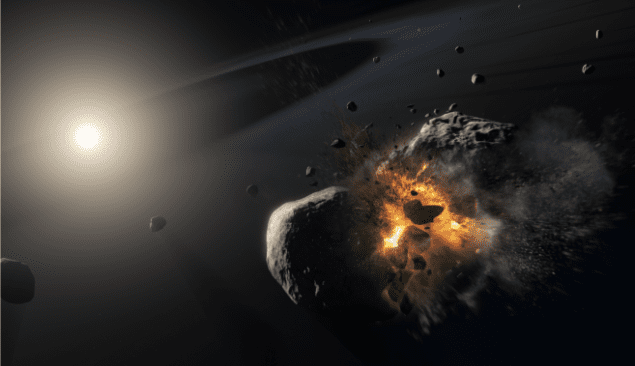
An enigmatic object once thought to be a massive exoplanet is more likely to be the remnants of a catastrophic collision between two comet-like bodies, two US astronomers have shown. Andras Gaspar and George Rieke at the University of Arizona made the discovery after re-analysing observations of the Fomalhaut system made by the Hubble Space Telescope (HST). Their proposal could improve our understanding of how orbiting bodies can destroy each other, even in more peaceful star systems.
In 2008 a team of US astronomers announced the discovery of a massive exoplanet orbiting the bright star Fomalhaut. Unusually, the new exoplanet was imaged directly, using observations from the HST, rather than having its existence inferred from its effects on the orbit or brightness of its parent star. Since then, however, the object has thrown up a few puzzles for observers. Unlike planets with similar masses, it is optically bright but emits virtually no infrared radiation. In addition, it appears to have far less gravitational influence on Fomalhaut’s debris disc than astronomers first predicted, suggesting that Fomalhaut b is much less massive than initially thought.
Gaspar and Rieke have now shed new light on the mystery by revisiting previous data from the HST. Through this analysis, they concluded that Fomalhaut b has both expanded and faded since its discovery, and also appears to be on a trajectory that would see it escape from its host star. This would only be possible if Fomalhaut b were not a planet after all, but a dispersing cloud of fine dust being pushed away by energy radiated from its host star. The duo further strengthened their hypothesis by creating simulations of expanding dust clouds under similar radiation pressure, and demonstrating that the clouds’ behaviour was consistent with the HST’s observations.
Gaspar and Rieke believe that the only plausible explanation for their proposed cloud’s origin is a recent catastrophic collision between two comet-like planetesimals, each around 200 km across. Such a collision would be a rare event, occurring perhaps once in every 200,000 years in a system like Fomalhaut, which has long since passed through its violent early formation stages. This suggests that Fomalhaut’s planetesimals could be undergoing a reshuffling, driven by the evolving orbits of other, as-yet undetected planets in the system.

‘Super-puff’ exoplanets put a ring on it
The duo now hopes to learn more about the circumstances of Fomalhaut b’s formation by directly imaging the inner regions of its host system, which will be possible after the long-awaited launch of the James Webb Space Telescope. By identifying the orbits of actual exoplanets in the system, and exploring the architecture of Fomalhaut’s debris disc in more detail, their future research could produce new insights on how such major events could occur in seemingly uneventful star systems.



